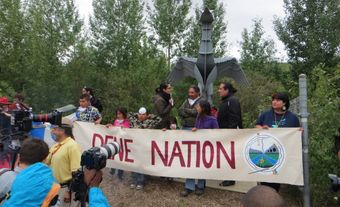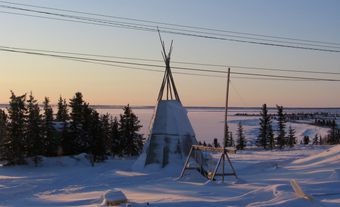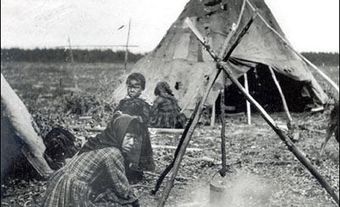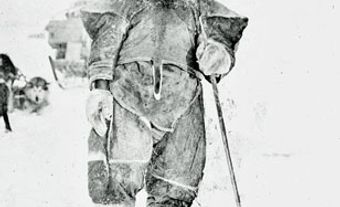Tlicho (Tłı̨chǫ), also known as Dogrib, are an Indigenous people in Canada. They fall within the broader designation of Dene, who are Indigenous peoples of the widespread Athapaskan (or Athabascan) language family. Their name for themselves is Doné, meaning "the People." To distinguish themselves from their Dene neighbours, including the Denesuline, Slavey, Sahtu Got'ine and K'asho Got'ine, they have come to identify themselves as Tlicho, a Cree word meaning “dog's rib,” referring to a creation story. In 2005, the Tlicho Agreement, which saw the Tlicho gain control of 39,000 km2 of their traditional lands, became the first combined self-government agreement and comprehensive land claim in the Northwest Territories. According to the Northwest Territories Bureau of Statistics (2019), the population of the Tlicho region of the territory was 2,983.
(courtesy Native Land Digital / Native-Land.ca)
Traditional Territory
Tlicho lands lie east of the Mackenzie River between Great Slave Lake and Great Bear Lake in the Northwest Territories. In 2005, the Tlicho Land Claim and Self-Government Act granted Tlicho ownership of 39,000 km2 of land in this area, including surface and subsurface rights.
The Tlicho have four communities: Behchokǫ̀ (formerly Rae-Edzo), which is the most populous settlement, Whatì (formerly Lac la Martre), Gamètì (formerly Rae Lakes) and Wekweètì (formerly Snare Lake).
Population
From a population of about 800 (in the mid-19th century), the Tlicho numbered some 1,700 by 1970, over 2,000 by 1996, and the 2006 census recorded 2,020. According to the Northwest Territories Bureau of Statistics (2019), the population of the Tlicho region in the territory was 2,983. This population growth reflects a larger trend among Indigenous peoples in Canada; since 2006, the Indigenous population has grown by 42.5 per cent.
Traditional Life
Extended kinship ties in Tlicho society and culture have allowed for the easy movement of families from one band to another.
From ancient times to the present, Tlicho have hunted the barren-ground caribou in the boreal forest during winter and followed them to the edge of the barrens in spring, where they meet them again in the fall. Moose and hare of the forest, and migratory waterfowl and fish have also been important food resources for Tlicho people.
Within each Tlicho community, hunting prowess coupled with generous concern for the well-being of the group, wisdom, oratorical skills and "medicine" power (supernatural power granted through the aid of animal-spiritual beings) led to authority and leadership.

Tlicho (Dogrib) girls in Fort Rae, Northwest Territories, 1937.
Language
The Tlicho language (or Dogrib) is a Dene language. According to the 2016 Statistics Canada census, 1,695 people reported knowledge of the language. Tlicho is an official language of the Northwest Territories and one of two official languages of the Tlicho government (the other is English). (See also Indigenous Languages in Canada.)
History
In the early 19th century, Tlicho were intimidated and attacked by members of the Yellowknives band. However, in 1823 a massacre by Tlicho of a Yellowknives group led by the leader Long Leg broke the threat. Tlicho oral tradition describes how, a few years after the massacre, the Tlicho chief Edzo and a few companions met the great Yellowknives leader, Akaitcho, and members of his band, and by medicine power and oratorical force brought a lasting peace.
Fort Rae (1852), on the north arm of Great Slave Lake, was the first trading post established on the Tlicho lands. Tlicho began to be drawn into the fur trade around the beginning of the 19th century. In some Tlicho communities, the traditional reliance on hunting, fishing and fur trapping remains vital. Fur trapping as a traditional activity, has been declining steadily since the late 1980s and it is widely held in the north that this is a direct consequence of the animal-rights movements. With the development of diamond mines within traditional Tlicho lands, many men and women are employed by the mines or the mining support industries.
Roman Catholic missionaries began the conversion of Tlicho in 1859. Like many other Indigenous peoples in Canada, Tlicho children were sent to residential schools where they were forced to abandon their language, culture and customs. Schools that were established at Tlicho settlements during the late 1950s facilitated access to southern schooling and prepared children for non-traditional occupations.
Treaty 11
In 1921, Tlicho, with other Dene groups of Great Slave Lake, signed Treaty 11. With increasing development pressure in the Mackenzie River valley during the 1960s and 1970s, and with many provisions of the treaty that were never fulfilled, the Dene lobbied the federal government to secure their political, land, and other rights in the Northwest Territories. (See also Numbered Treaties.)
Tlicho Land Claim
Beginning in 1981, the Dene Nation (an organization that represents various Dene peoples, including the Tlicho), negotiated a comprehensive land claim with the federal government. When the Dene leadership voted to reject the final draft agreement in 1990, negotiations collapsed, and the federal government began negotiating separate agreements with regional Dene groups.
In 1995, the Tlicho began negotiating a separate land claim based on a unique formula by including provisions of both a comprehensive land claim and a self-government agreement. The Tlicho Land Claim and Self Government Act received Royal Assent on 10 February 2005. Since that time, the newly formed Tlicho government established a working governance structure that provides programs and services to manage the various provisions of the land claim.
The claim provided the Tlicho with ownership of 39 000 km2 of land in a single block, shared management rights over Crown Land within the claim area, $152 million in compensation paid out over 14 years and a share of federal mineral royalties from the Mackenzie valley. As well, the claim grants law-making authority over Tlicho citizens in Tlicho communities on Tlicho lands. It also includes aspects of education, adoption, child and family services, training, income support, social housing, and Tlicho language and culture.
Modern Tlicho Government

Flag of the Tlicho government and people.
Tlicho government includes the Chief's Executive Council and the Tlicho Assembly. The Grand Chief and chiefs from each of the four Tlicho communities make up the Chief’s Executive Council, which oversees the enactment of Tlicho laws. The Tlicho Assembly, made up of 13 members, including chiefs and community council representatives, is the law-making body of the government. It is also tasked with implementing the land claims agreement, protecting the rights of the government and ensuring good government.

 Share on Facebook
Share on Facebook Share on X
Share on X Share by Email
Share by Email Share on Google Classroom
Share on Google Classroom






